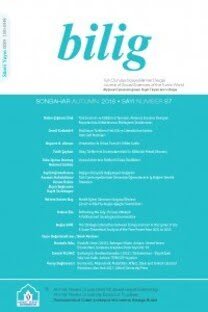Ekonomik Rehabilitasyon Süreci ve Yatırım Çevresi: Bosna Hersek Örneği
Çatışma, Ekonomik Yapılanma, Bosna Hersek, Dünya Bankası, Yatırım Çevresi
Investment Climate, Economic Recovery and Reconstruction Process: The Bosnian Case
Conflict Economic Recovery, Reconstruction, Bosnia and Herzegovina, World Bank, Investment Climate,
___
- Collier, Paul. (1999a). “Doing Well out of War”. Conference on Economic Agendas in Civil Wars. London: April.
- _____, (1999b). “On the Economic Consequences of Civil War”. Oxford Economic Papers 51 (1): 168-183.
- Collier, Paul ve Hoeffler, Anke ve Mans Soderbom, H. (2007). Post-Conflict Risks. Center for the Study of American economics. Oxford. 2-19.
- Collier, Paul ve Anke Hoeffler (2002). “On the Incidence of Civil War in Africa”. Journal of Conflict Resolution 46 (1): 13-28.
- _____, (2004). “Greed and Grievance in Civil War”. Oxford Economic Papers 56: 563-73.
- Collier, Paul ve Anke Hoeffler. ve Dominic Rohner.(2006). “Beyond Greed and Grievance: Feasibility and Civil War”. Working Paper 10. Center for the Study of African Economics.
- Effeon, Laurie. ve Stephen O’brien. (2004). Bosnia and Herzegovina: Country Asistan and Evaluation. Washington: World Bank Publication.
- Evans, Alex (2011). Resource Scarcity, Climate Change and The Risk of Violent Conflict. Ed. World Bank: World Development Reports.
- Goertz, Gary ve Patrick Regan (1997). “Conflict Management in Enduring Rivalries International Interactions”. Empirical and Theoretical Research in International Relations 22(4): 321-34. Hacıoğlu, Ümit (2008). “Tanıdık Tehlike Çanlarının Yeni Adresi: Kosova Bosna Ekseni”. Stratejik Araştırmalar Dergisi 1(2): 189- 212.
- _____, (2009). Challenging Issue of Sustainable Interethnic Peace and Security: Which Strategy Secures Best in the Balkans. 2nd International Symposium on the Strategy and Security Studies. İstanbul: BUSAM: 16-17.
- _____, (2010). The Role of Energy on Security and Stability in Post Conflict Countries (PCCs). Proceedings of the 3rd International Symposium on the Strategy and Security Studies. İstanbul: BUSAM: 15-16 April.
- _____, (2012). “Interethnic Peace, Security and Genocide in Bosnia and Herzegovina”. International Journal of Research in Business and Social Sciences 1 (1): 29-38.
- Hacıoğlu, Ümit, Hasan Dinçer ve İ. Erkan Çelik (2012a). “Economic Approach to Conflict Issue: Investment in Post- Conflict Situation for International Business”. International Journal of Business Administration 3(5):1-8.
- _____, (2012b). “Risky Business in Conflict Zones: Opportunities and Threats in Post Conflict Economies”. American Journal of Business and Management 1 (2): 76-82.
- _____, (2013). “Financial contributions and economic outlook in Bosnia from
- Dayton to 2008 global economic recession”. Global Business and Economics Research Journal 2 (2): 12-28.
- Holbrooke, Richard (1998). To End a War. New York: Random House.
- Hoogenboom, David A. and Stephanie Vieille (2010). “Rebuilding Social Fabric in Failed States: Examining Transitional Justice in Bosnia”. Human Rights Review (11): 183–198. Izyumov, Alexei ve John Vahaly (2006). “New Capital Accumulation in
- Ttransition Economies: Implications for Capital-labor and Capital-output ratios”. Economic Change 39: 63–83.
- Lucas, E. Robert (1988). “On the Mechanics of Economic Development”. Journal of Monetary Economics 22: 3-42.
- Mankiw, N.Gregory (1995). “The Growth of Nations”. Brooking Papers on Economic Activity (1): 275-326.
- Nesadurai, Helen (2004). “Introduction: Economic Security, Globalization and Governance”. The Pacific Review 17 (4): 459-484.
- Nicholas, Sambadis (2001). “Do Ethnic and Nonethnic Civil Wars Have the Same Causes?”. Journal of Conflict Resolution 45 (3): 259-282.
- Norris, David (1999). In the Wake of the Balkan Myth: Questions of Identity and Modernity. New York: St. Martin’s Pres Inc.
- Orhan, Osman Z., Cemal Zehir ve Ümit Hacıoğlu (2009). “Çatışma Riskinin Ekonomik Analizi”. Stratejik Araştırmalar Dergisi. İstanbul: BUSAM.
- Chhibber, Ajay, R. Kyle Peters, and Barbara J. Yale (2004). “Reform and Growth: Evaluating the World Bank Experience”. OECD Conference Presentations. Washington: World Bank.
- Rozen, Laura Kay (1996). “For Bosnians, A Jobless Peace: Economy Struggles to Revive”. Christian Science Monitor. http://www.csmonitor.com/1996/1120/112096.econ.econ.1.html.
- Schwartz, Jordan, Shelly Hahn, ve Ian Bannon (2004). “The Private Sector’s Role in the Provision of Infrastructure in Post Conflict Countries”. PublicPrivate Infrastructure Advisory Facility, Trends and Policy Options. Washington: World Bank.
- Starr, Martha (2004). “Monetary Policy in Post-Conflict Countries: Restoring Credibility”. Working Paper Series. Washington: American University. 1-7.
- Yenigün, Cüneyt ve Ümit Hacıoğlu (2010). “Bosna Hersek: Etnik Savaş-Eksik Antlaşma”. Dünya Çatışma Bölgeleri. Der. K. İnat vd. İstanbul: Nobel Yay.
- ISSN: 1301-0549
- Yayın Aralığı: Yılda 4 Sayı
- Başlangıç: 1996
- Yayıncı: Ahmet Yesevi Üniversitesi
Altayistik Bağlamında Macarca-Türkçe Dil İlişkileri
Avrupa Birliği Ülkeleri ve Türkiye’de Yükseköğretimde Etkinliği Belirleyen Faktörler
Sibel Aybarç Bursalıoğlu, Sibel Selim
Cengiz Aytmatov’un Al Yazmalım Selvi Boylum Hikâyesi ve Göstergelerarasılık
Niğbolu Sancağı’nda Değişen Göçmen Profili ve Yerleşimleri
Kazakistan’da Millet İnşası: Kazak ve Kazakistan Kimlikleri Tartışması
Nurken AİTYMBETOV, Ermek TOKTAROV, Yenlik ORMAKHANOVA
Lord Byron’ın The Giaour (Gâvur) Adlı Hikâyesinde Türk Kültüründen İzler
Müzik Coğrafyası: Türkülerdeki Coğrafya
Muhittin KAPLAN, Abdullah YUVACI, Shatlyk AMANOV
Ekonomik Rehabilitasyon Süreci ve Yatırım Çevresi: Bosna Hersek Örneği
Ümit Hacıoğlu, Hasan Dinçer, İ.Erkan Çelik
Hollanda’da Türkçe Konuşurlarında Dili Koruma ve Değiştirme Kalıpları
